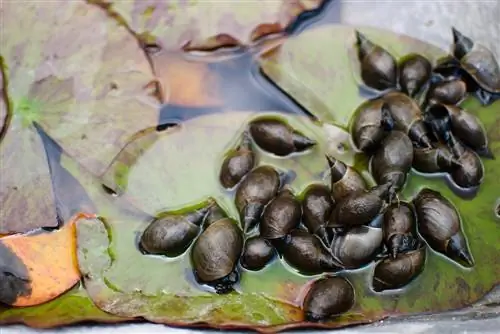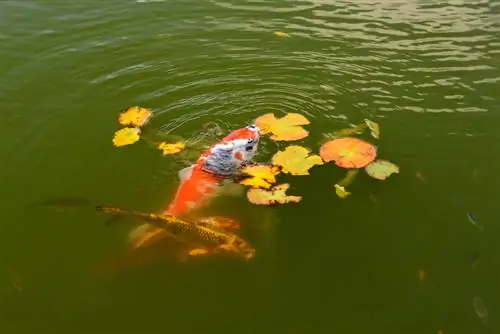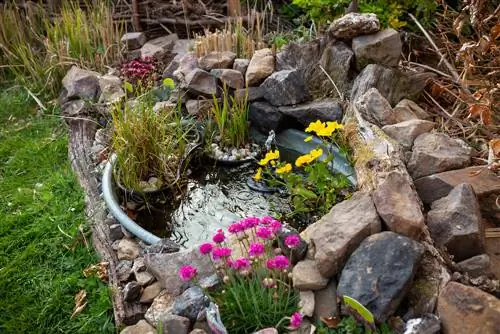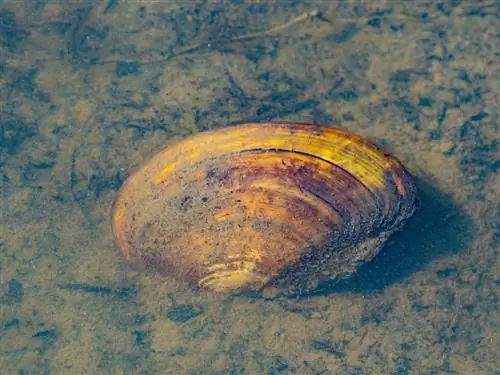- Author admin [email protected].
- Public 2023-12-16 16:46.
- Last modified 2025-01-23 11:22.
Enclosed surface waters are subject to natural fluctuations caused by introduced plant substances. If there is an explosive proliferation of algae, the parameters in the water are no longer in balance. But home remedies usually make the situation worse.
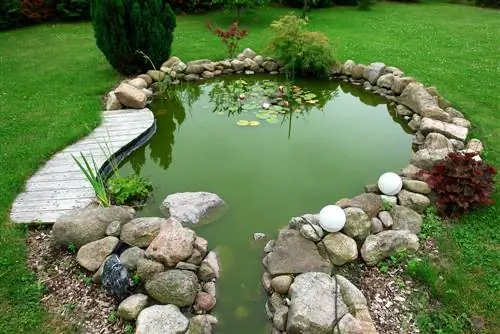
How can you fight algae in the pond naturally?
To effectively combat algae in the pond, avoid excess nutrients, promote the growth of aquatic plants and use natural algae killers such as snails or certain types of fish. Chemical products and home remedies should be avoided in order not to damage the ecosystem.
Why do algae form in the pond?
Algae, like any plant, need nutrients and sunlight. The different species coexist in a pond with a balanced nutrient concentration. If the phosphate content increases to more than 0.035 milligrams per liter, the living conditions for algae improve. In the summer months the water warms up significantly and the incidence of light increases in the lower layers. When all conditions are in favor of algae growth, explosive proliferation often occurs.
Bodies of water are constantly changing. Under natural conditions, an equilibrium is automatically established.
Possible nutrient sources:
- Fish poop or excess food
- Leaching of nutrients from fertilized lawns and beds
- Autumn leaves and pollen sinking to the bottom of the water
Do algae in the pond produce too much oxygen?
The plants release oxygen through tiny pores. This rises to the surface of the water in the form of small bubbles. The more algae grow in the water, the higher the oxygen production. This occurs cyclically because the plants use large amounts of oxygen at night. Dead filamentous algae sink to the bottom and are decomposed by microorganisms. Oxygen is also needed for this. In an unbalanced ecosystem, this can be disastrous for the fish.

Algae consume and produce oxygen
Excursus
pH and KH value
A stable pH value is important for a pond because it also influences other parameters in the water. The value depends on the water or carbonate hardness, which is called the KH value. If this is too low, the pH will fluctuate. But this value is also subject to natural fluctuations over the course of the day. The optimal pH value for a pond fluctuates between 7.5 and 8.5. The more turbidity and nutrients there are in the water, the higher the value increases. If this is more than 8.5, an algae bloom is not far away.
What helps against algae?
Waters are sensitive ecosystems that react strongly to changes. Within a short period of time, flora and fauna can develop in different directions. These processes depend largely on the means you use. Basically, you should not pour chemical products or home remedies into the pond. They do not correspond to the natural state and can do more harm than good to the water. Excessive amounts of algae should be fished with a landing net. You can easily dispose of these in the compost.

Vaccination
Take about ten to 20 liters of water from an intact pond and pour it into the eutrophic pond. In this way, you bring numerous microorganisms into the water, which naturally curb the growth of algae. Alternatively, you can also use starter bacteria (€10.00 on Amazon). These highly active microorganisms are added directly to the filter or simply to the water.
Nitrogen deprivation
Store a jute bag filled with straw directly in the pond. Within four to five weeks, microorganisms cause the straw to decompose. Large amounts of nitrogen are consumed and the rotted material can then be composted or used as mulch. You can do a similar thing with peat, oak wood or barley straw pellets. These ensure that the pH value of the water is lowered and algae growth is restricted.
Renewal
If new algae keep developing, you should think about renovating the water. The entire substrate is removed from the bottom so that the pond is no longer polluted by fish droppings, leftover food and rotten plant material. Replace the old pond soil with a nutrient-poor substrate. Cut back or divide all plants vigorously before placing them back in the pond.
Improve water quality permanently
A pump ensures that the water stays pure. Sometimes it happens that algae develops in the water despite the pump. Get to the bottom of the problem and instead ensure that the water is filtered naturally. Natural flora and fauna keep algae growth in check.
Plants against algae in the pond
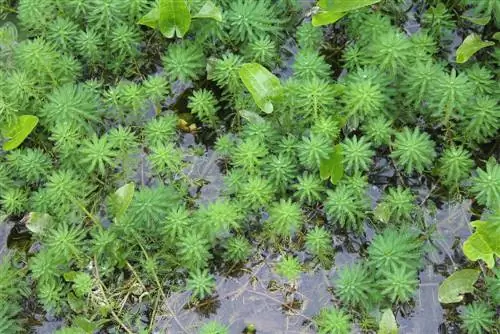
The milfoil prevents algae infestation
Swamp and floating plants or completely submerged plants compete with algae because they also need nitrogen to grow.
- Thousandleaf: Myriophyllum spicatum or Myriophyllum verticillatum
- Ranunculus: Ranunculus aquatilis or Ranunculus trichophyllus
- Waterweed: strong-growing Elodea canadensis or Elodea densa
- Water hose: demanding Urticularia vulgaris or Urticularia minor
Floating and swamp plants such as the aesthetically flowering water hyacinth, crab claws or water nut provide more variety for the eye. Plants in swampy locations in particular are strong nitrogen consumers and are suitable for improving pond quality in the long term.
Salad
In theory, lettuce varieties can also be cultivated on the surface of the water. The weak feeders remove small amounts of nutrients from the water, which are no longer available to the algae. The floating islands also provide shade and prevent heat development in the pond. To achieve success, however, many lettuce plants must be placed on the water.
How to build a salad island:
- Fill plastic pots with gravel
- Insert lettuce plants
- Put pots in a Styrofoam ring
This variant is a short-term way to reduce the nutrient content in the water. After a while, lettuce etc. stop growing. If the water is no longer sufficiently saturated with oxygen, the roots can no longer absorb nutrients. In addition, they begin to rot in the absence of air. In hydroponics, all parameters are measured permanently so that they can be kept at a constant level.
Which fish eat algae in the pond?
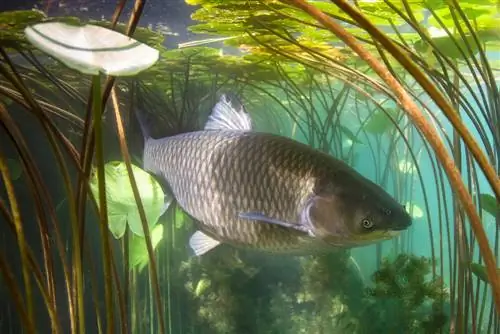
Grass carp eat thread algae
There are some species of fish that clean the pond naturally. However, they do not eat the filamentous algae but rather the free-swimming phytoplankton. An exception are grass carp, which like to eat plant-based food when there is no feeding. The rudd remains relatively small at 20 to 30 centimeters and can also be found in the front garden pond. Like the silver carp, it is an algae eater. This type of fish feels comfortable in larger bodies of water. It grows up to 130 centimeters long.
Snails against algae in the pond
Water snails are considered algae lawn mowers because they scrape off the pond bottom with their sharp mouthparts. Various species filter floating algae from the water and eat the algae growth on stones and the subsoil. However, gill breathers need enough oxygen in the water to survive. Lung-breathing snails come to the surface of the water to absorb oxygen.
- Gill breather: Marsh snail
- Lung breathers: black mud snail, ramshorn snail
Inappropriate means
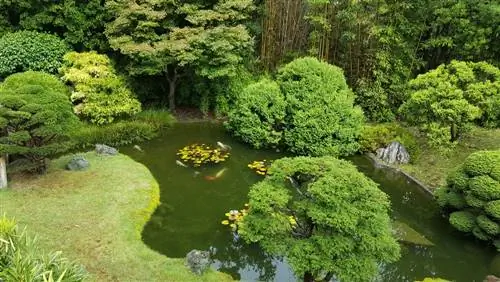
Algae in the fish pond should not be combated with home remedies in order not to harm the fish
The idea of combating algae growth without chemicals is fundamentally positive. All home remedies aim to change a parameter in the water. Although algae are combated in the short term, these measures are not permanent. As long as the pond ecosystem is not in balance, no remedy will bring the desired success.
Reasons against home remedies:
- Aquatic plants and fish like stable conditions
- short-term and strong changes in individual parameters weaken living beings
- Algae recover from fluctuations more quickly than aquatic plants
Milk
Milk contains lactic acid bacteria and large amounts of protein, fat and lactose. Not only does it cause cloudiness in the water, but it also supplies it with additional nutrients. An even greater imbalance arises and the water quality suffers from the input. It has not been proven that milk actually helps against algae. The same applies to bread drinks.
Vinegar
Vinegar is a natural remedy and is used to lower acutely elevated pH values. The liquid influences the KH value, which causes the pH to fluctuate. The acetic acid is broken down using oxygen, leaving s alts behind. Fruit vinegars contain additional nutrients that can pollute the water.
Unsuitable means with similar effects:
- Ascorbic acid or vitamin C
- Oxalic or clover acid
- Citric acid and apple cider vinegar
S alt
In common usage, various substances are referred to as s alt. Dissolved ions play an important role for a body of water. Pond plants and fish could not survive in an ion-free pond. Ions also ensure stable conductivity and influence water hardness. The s alt balance of a pond largely determines plant growth. Small doses of s alt can have a positive effect on water quality. However, other pond creatures that are adapted to freshwater often suffer from this.
| consists of | Examples | |
|---|---|---|
| Crystalline S alts | Anions and Cations | Sodium chloride, calcium chloride, acetates |
| table s alt | Sodium chloride | Sea s alt, table s alt, black s alt |
| Mineral s alt | inorganic nutrients | Iron, zinc, calcium |
Zinc Oxide
Zinc, like copper, is a vital substance that living beings need in low concentrations. Zinc oxide is a white powder that is formed when zinc is burned in the presence of oxygen. It is largely insoluble in water and is considered hazardous to the environment. Because of its antibacterial effect, it should not be applied to water. Although many reports show positive success in combating algae, the water is still unbalanced. Important Microorganisms die, leading to long-term damage.
How zinc works on algae:
- Ions enter cells
- oxidative stress occurs
- reduced growth rate
Tip
Do not add baking soda to the water. It increases the KH value and can quickly affect plant growth.
Types of algae in the pond

Some species grow over surfaces, others swim freely in the water. There are also algae that develop striking structures. Most of the time, dead algae float on the surface of the water and form unsightly nests.

Floating algae
These green algae are microscopic and swim freely in the water. Because they can multiply quickly, they give the water a corresponding color. During algae blooms, the pond can be so cloudy that the visibility depth is a few centimeters. This occurs in spring when temperatures rise, even before the pond plants begin to grow. Floating algae use the nutrients and grow until aquatic plants take away the nutrients.
Thread algae
They can also grow in low water temperatures and in winter. Their striking growth habit makes them unmistakable. The algae develop long threads that root on stones, other plants or the bottom of the pond. Occasionally they form nests of algae floating freely on the water. Warm temperatures promote their growth, which is why they should be fished out of the water regularly.
Blue-green algae
Behind the slimy algae in the pond there are often blue-green algae, which are actually not algae but bacteria. These organisms float on the surface of the water and form a fur-like coating on the leaves and stems of aquatic plants. The unpleasant smell is typical.
Why blue-green algae occurs:
- Filter system does not work optimally
- too much ammonium in the water
- overfeeding the fish
- Fishing ponds are severely overstocked
Brown algae
The brown algae are mainly found in deeper water zones. Their brownish to reddish color is typical. The algae grow on stones in the pond or colonize pond walls. These organisms also grow in conditions of lack of light and low nutrient availability.
Tip
Brown algae can simply be vacuumed up as they do not adhere particularly firmly to the surface.
Bearded Algae
They are often confused with filamentous algae because of their structure. Bearded algae form long runners and grow around plant stems. They often arise in ponds with weak water flow. They thrive in low carbon dioxide concentrations and are favored by excessive feeding. Bearded algae are difficult to fish out of the pond.
Frequently asked questions
When does algae form in the pond?
There are different types of algae that are adapted to different living conditions. The species found in garden ponds prefer to grow in spring and summer with high nutrient availability. They benefit from rising water temperatures and sunlight.
What to do about algae in the pond?
Fighting the algae naturally is difficult. Water bodies are sensitive ecosystems and should not be contaminated with household remedies. If there is a lot of algae growth, fishing out the floating parts helps. Make sure there are enough plants growing in the pond. Aquatic and swamp plants that sprout particularly early ensure that the algae do not have enough nutrients available.
Are algae harmful in ponds?
Basically, algae are not a problem for fish. They enrich the water with oxygen, which benefits aquatic life. If the ecosystem becomes imbalanced so that algae growth dominates, the fish can be negatively affected.
Do aquatic plants help against algae in the pond?
Aquatic and marsh plants are the best way to naturally limit algae growth. They remove nutrients from the water and provide shade so that the water does not warm up excessively. An intact pond contains various living beings that contribute their part to the functioning ecosystem.
Why do algae form despite a UV lamp?
The UV lamp destroys floating algae, but not filamentous algae. If the dead algae particles are not removed from the water immediately, they will decompose and release nutrients again. Other algae that compete with the floating algae benefit from this.


